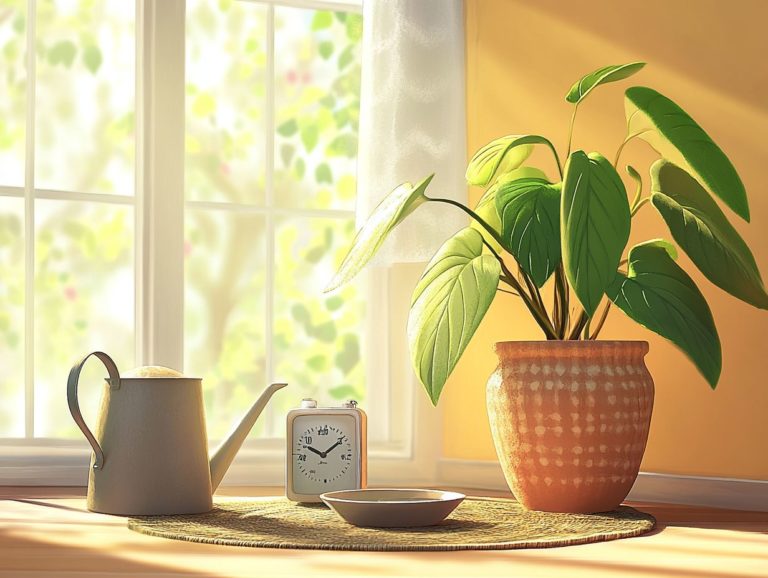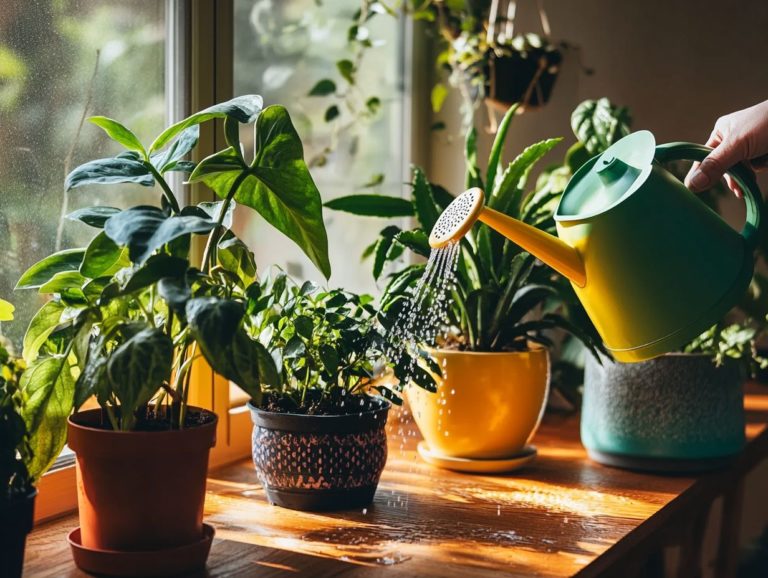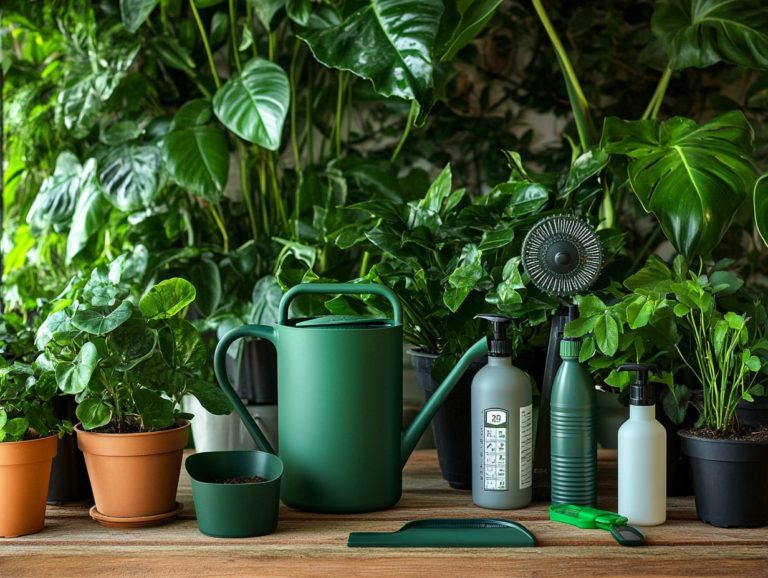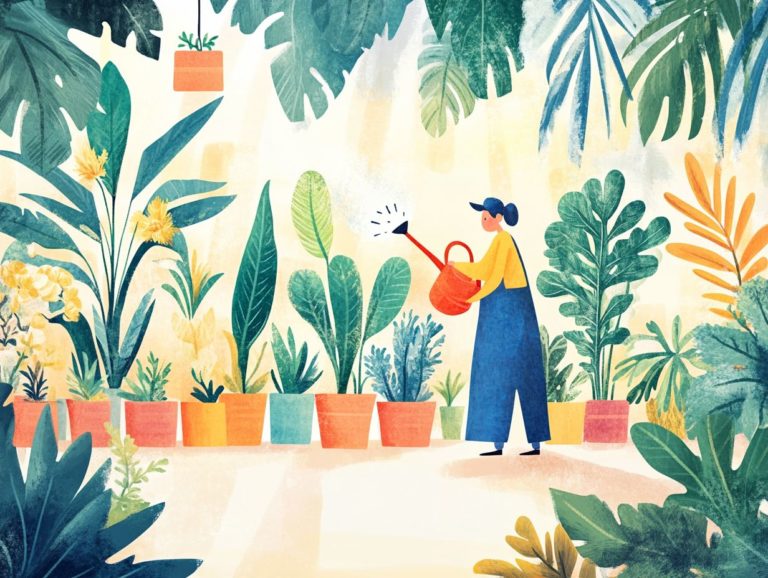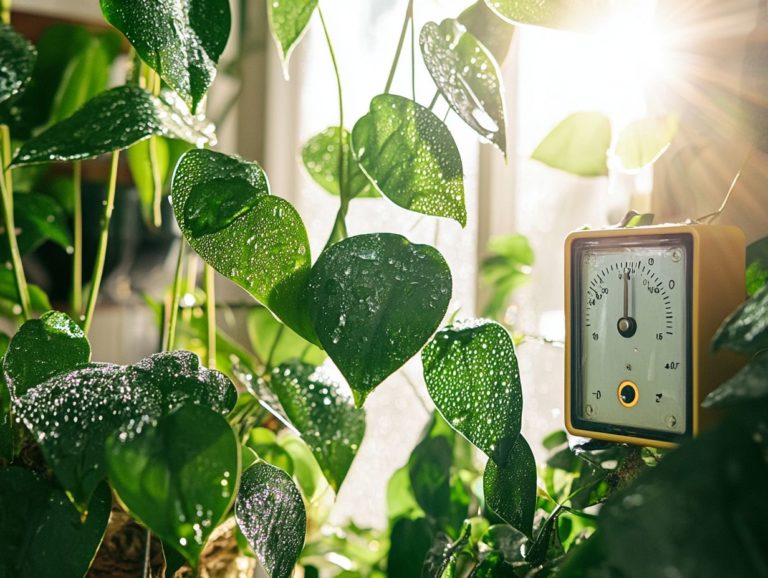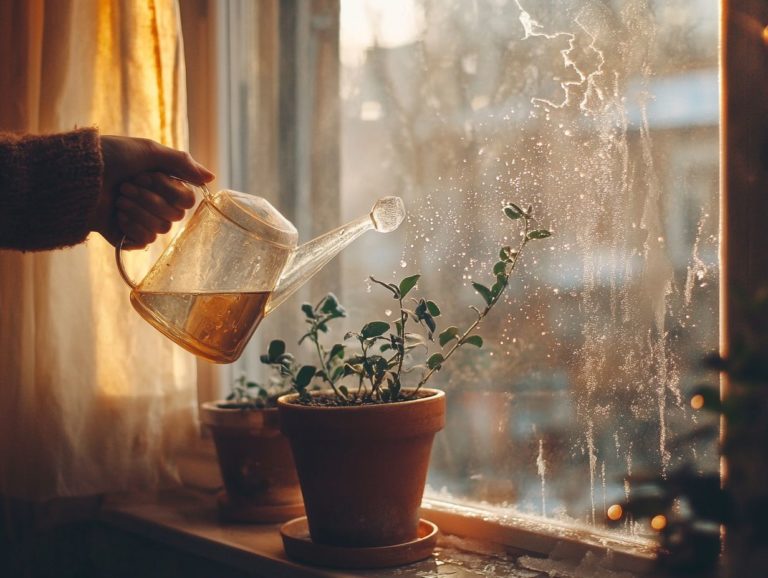5 Methods to Water Hanging Plants
Hanging plants can truly elevate any space, but their unique positioning can make watering a bit of a challenge. Fortunately, you have several effective methods to ensure your greenery thrives. This article delves into five practical ways to water your hanging plants, from the trusty watering can to innovative drip irrigation systems.
You ll also find essential tips on how frequently to water, how to recognize signs of underwatering or overwatering, and strategies to keep your plants hydrated even when you re away. Whether you re a seasoned gardener or just getting started, these insights will empower you to maintain the health and vitality of your hanging plants!
Contents
- Key Takeaways:
- 1. Using a Watering Can
- 2. Using a Drip Irrigation System
- 3. Using a Self-Watering Hanging Basket
- 4. Using a Watering Wand
- 5. Using a Watering Globe
- How Often Should Hanging Plants Be Watered?
- Frequently Asked Questions
- What are the 5 methods to water hanging plants?
- How do I hand water hanging plants?
- What are self-watering containers and how do they work?
- Can I use drip irrigation for hanging plants?
- How does wicking work for watering hanging plants?
- What is bottom watering and when should I use it for hanging plants?
Key Takeaways:
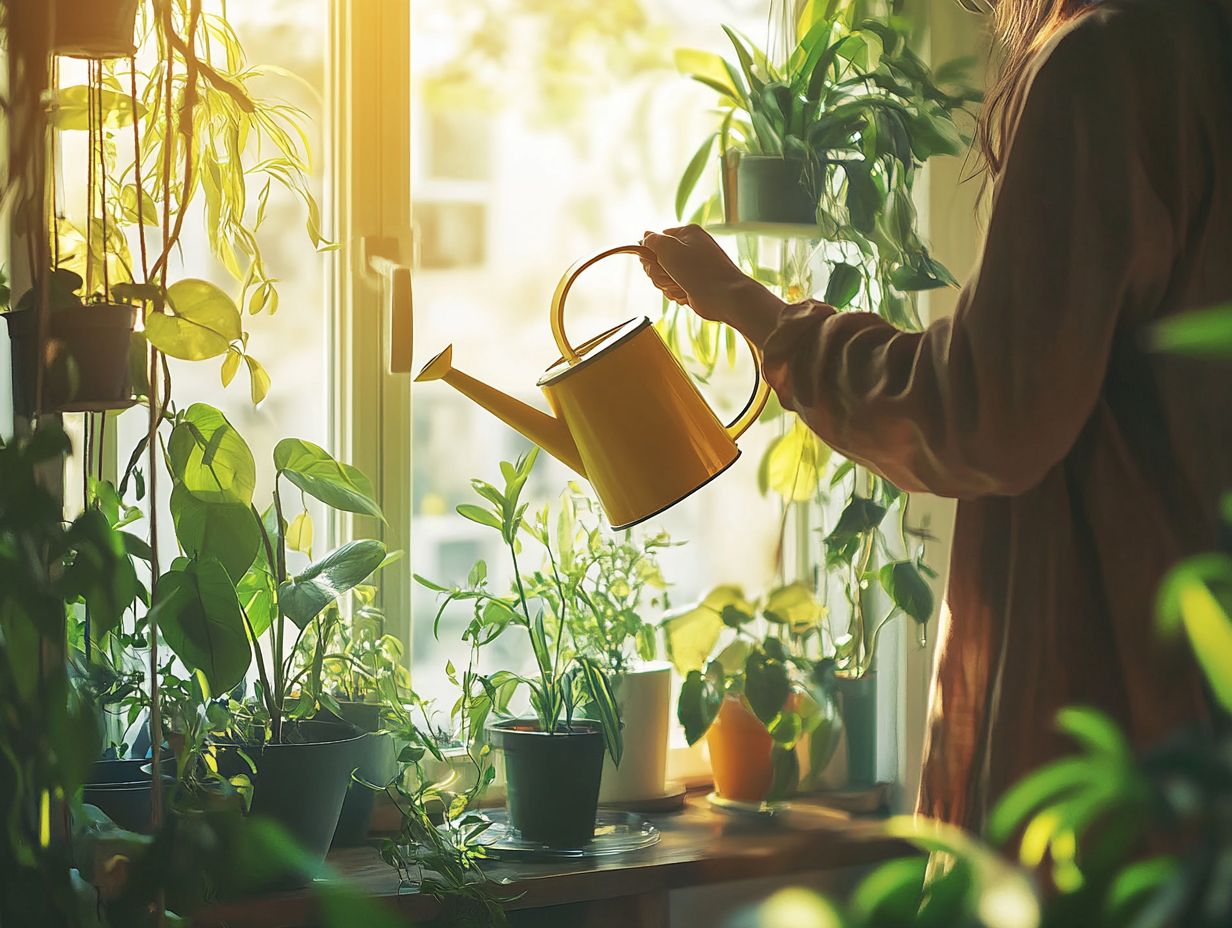
- Use a watering can for precise watering and control over the amount of water given to hanging plants.
- Invest in a drip irrigation system for efficient and consistent watering of summer flowers without manual effort.
- Consider using a self-watering hanging basket to provide a steady supply of water to your plants while reducing the need for frequent watering.
1. Using a Watering Can
Using a watering can is one of the most timeless and effective ways to ensure your hanging baskets thrive, especially in the summer when vibrant flowers like petunias and geraniums bloom. This method provides the right moisture levels and nutrients essential for optimal growth.
When choosing a watering can, consider its capacity to suit your needs. A larger can is more efficient for multiple baskets, while a smaller one allows for better control in tight spots. Look for a well-designed spout that enables targeted watering, minimizing the chances of over-saturation. Be sure to check the soil moisture before watering; this simple step helps avoid the pitfalls of under or over-watering, which can stress your plants.
In the sweltering summer heat, establishing a consistent watering routine can make a world of difference. Early morning sessions are particularly beneficial, as they help reduce evaporation and stress for your beloved plants!
2. Using a Drip Irrigation System
A drip irrigation system is a great solution for your garden! It ensures your hanging baskets receive consistent moisture levels while effectively meeting the nutrient requirements of summer flowers like petunias and geraniums.
This irrigation method comprises key components, including a reliable water source, a filter to remove debris, a pressure regulator to maintain optimal pressure, and a network of tubing or hoses that directs water precisely where it s needed.
Setting up a drip system for your hanging baskets is quite simple. It generally involves affixing drip emitters to the tubing, which can be adjusted to allow for a slow and steady water release over time.
One standout benefit of this method is the substantial reduction in water waste compared to traditional watering techniques. It enables the direct application of water-soluble fertilizers, significantly enhancing plant growth by delivering essential nutrients right to the root zone.
3. Using a Self-Watering Hanging Basket
Self-watering hanging baskets present an innovative gardening solution that keeps moisture levels consistent for your root-bound plants, like petunias. This means healthier growth and significantly less maintenance for you!
These systems feature a clever reservoir of water that allows water to move up to the plants, ensuring they get just the right amount without the risk of drowning their roots. For those caring for low-light plants, following 5 tips for watering low-light plants can be particularly beneficial. This thoughtful design prevents overwatering while promoting optimal flower growth during the hot summer months when dehydration can be a real concern.
For passionate gardeners, monitoring soil moisture transforms from a tedious task into a breeze. With these advanced systems in place, you can relax and appreciate the stunning beauty of your hanging baskets, rather than fretting over your watering routine!
4. Using a Watering Wand
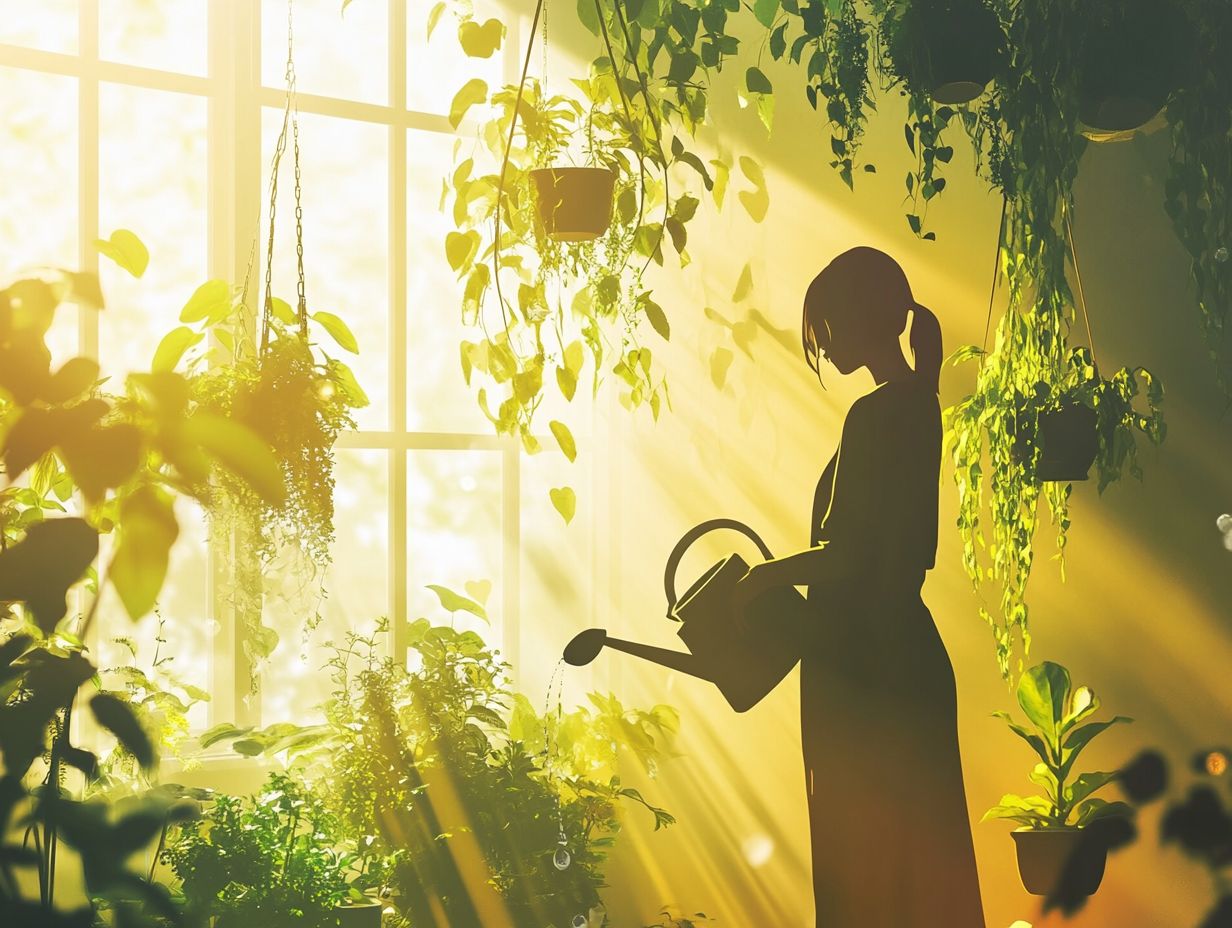
A watering wand is a versatile tool that allows you to water hanging baskets with precision. It ensures that water reaches the soil at the right moisture levels for healthy flower growth while minimizing the risk of overwatering.
With its extended reach and flexible design, you can effortlessly target hard-to-reach spots. This makes it essential for tending to elevated planters and baskets. No more cumbersome ladders or risky maneuvers are necessary!
To truly maximize the benefits of this tool, aim to water early in the morning. This reduces evaporation and ensures your plants absorb moisture efficiently.
Prioritize proper drainage to prevent excess water from suffocating the roots. This allows them to breathe and promotes healthier growth overall. By incorporating these practices into your gardening routine, you’ll love how vibrant your blooms become!
5. Using a Watering Globe
Watering globes are a new way to maintain soil moisture in your hanging baskets. They ensure your plants receive a consistent supply of water, especially during the demanding summer heat.
These clever devices work by slowly releasing water as the soil dries out. They foster healthy root development while preventing the pitfalls of overwatering. As the moisture level dips, air enters the globe, allowing it to draw in water from the reservoir.
This gradual release keeps your plants hydrated and minimizes the need for frequent manual watering. This gives you more time to enjoy your gardening pursuits.
By incorporating watering globes into your routine care, you can cultivate an ideal environment for your greenery, ensuring the moisture level is just right for vitality.
How Often Should Hanging Plants Be Watered?
Determining how often to water your hanging plants is crucial for keeping them healthy and vibrant, especially during hot summer days. Plants like petunias and geraniums crave extra attention to maintain optimal soil moisture.
Several factors influence your watering routine, including plant type, current weather conditions, and pot size. For example, succulents can thrive with less frequent watering, while tropical varieties prefer consistently moist soil.
During hot, dry spells, plants need more water to make up for rapid evaporation. Be attentive to signs of underwatering, such as wilting or brown leaf edges, which indicate a need for immediate moisture.
On the other hand, overwatering can lead to yellowing leaves and root rot. This signals it’s time to reevaluate your watering schedule. By keeping a close eye on these signals and adjusting your care regimen, you can maintain the perfect moisture balance for your plants.
What Are the Signs of Underwatering Hanging Plants?
Signs of underwatering in your hanging plants include wilting leaves, dry soil, and stunted growth. These suggest that your plants might not be getting the moisture they need to thrive.
Crispy leaf edges and a lack of vigor can indicate insufficient hydration. It’s essential to monitor soil moisture levels to avoid stress and hindered development.
To remedy the situation, refine your watering practices by establishing a regular schedule. Include early morning watering and employ deep watering techniques to ensure water reaches the roots.
Using moisture meters can also be a game-changer. They provide valuable insights into soil moisture, ensuring your plants receive the hydration necessary for recovery and flourishing.
Act now to ensure your plants flourish this summer! Try these techniques and share your results.
What Are the Signs of Overwatering Hanging Plants?
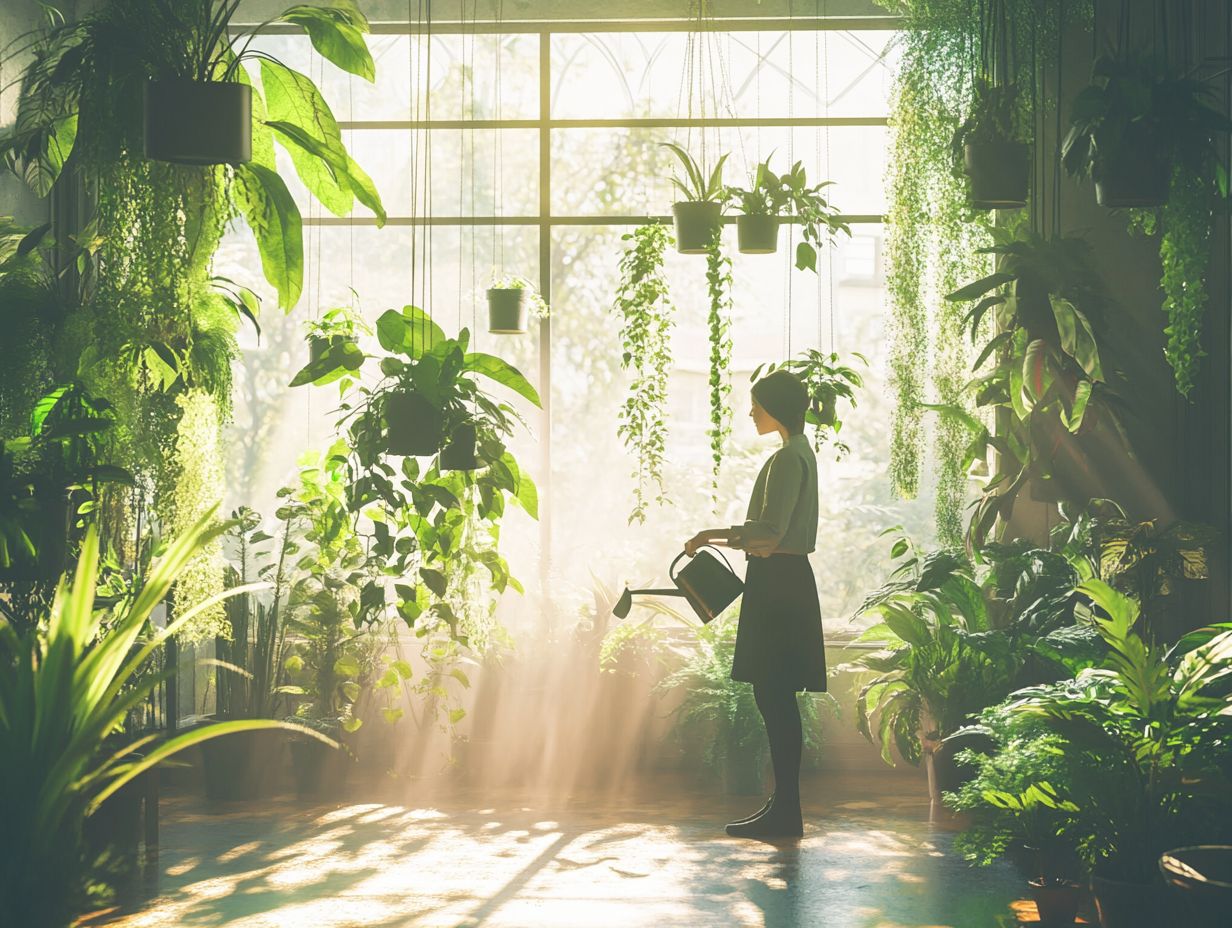
Overwatering your hanging plants can lead to distressing symptoms like yellowing leaves, root rot, and poor drainage. These issues can be serious for plants struggling with excess moisture or being root-bound.
To prevent these problems, it s essential to ensure that each pot has adequate drainage holes. This helps extra water flow out instead of collecting at the bottom. Pair that with the right soil composition a well-aerated mix that promotes proper drainage and you ll be on the right track.
When you start noticing signs of overwatering, such as unwanted yellow leaves or an unpleasant odor wafting from the soil, it s time to act swiftly. Consider letting the soil dry out between waterings or even repotting your plants in a drier, more suitable medium.
This way, you can restore a balanced watering routine and keep your plants thriving.
How Can I Prevent Water from Spilling Out of Hanging Baskets?
To prevent water from spilling out of your hanging baskets, it s essential to use the right potting soil and ensure that the drainage holes are appropriately sized to let excess water escape without flooding the container.
The choice of potting soil is pivotal. A well-draining mix enriched with organic matter will retain moisture while allowing for drainage, keeping your plants thriving.
Regularly adjusting your watering technique can significantly reduce spills. Use a watering can with a long spout or a drip tray to direct water precisely where it s needed.
Check the drainage systems regularly. Blockages can lead to soggy soil and drown your plants.
By keeping an eye on these factors, watch your beautiful hanging displays thrive and last longer with these easy tips!
What Are Some Tips for Watering Hanging Plants While on Vacation?
When planning your vacation, ensuring your hanging plants receive the right amount of care can be a bit of a balancing act. However, with a few straightforward strategies, you can maintain moisture levels and avoid the pitfalls of underwatering or overwatering while you’re away.
Taking a moment to check the moisture level a few days before you leave can truly make a difference. One effective approach is to set up a self-watering system, which will keep the soil consistently moist.
If you’re looking for something a bit more stylish, watering globes can be an elegant, low-maintenance solution, gradually releasing water as your plants need it.
For a more personal touch, you might consider asking a friend or neighbor to lend a hand in caring for your plants. Just provide them with clear instructions on watering schedules and moisture checks to ensure everything goes smoothly.
With these practical methods in place, you can indulge in your vacation, confident that your greenery is in good hands.
What Are Some Common Mistakes to Avoid When Watering Hanging Plants?
Avoiding common mistakes when watering hanging plants, such as inconsistent watering schedules and neglecting to check soil moisture, is crucial for promoting healthy growth and ensuring your plants receive the nutrients they need.
Homeowners often overlook the specific care requirements linked with different flower types, leading to improper watering and, ultimately, plant decline. While some plants thrive in drier conditions, others prefer consistently moist soil.
This lack of understanding can result in overwatering or underwatering, putting your plants at risk for root rot, which is when the roots start to decay due to too much water, or drought stress.
Many forget to consider factors like sunlight exposure and humidity levels, both of which can significantly affect how often you should water. By taking the time to research and grasp each plant s unique needs, you can create tailored care routines that support vibrant, flourishing hanging displays.
Frequently Asked Questions
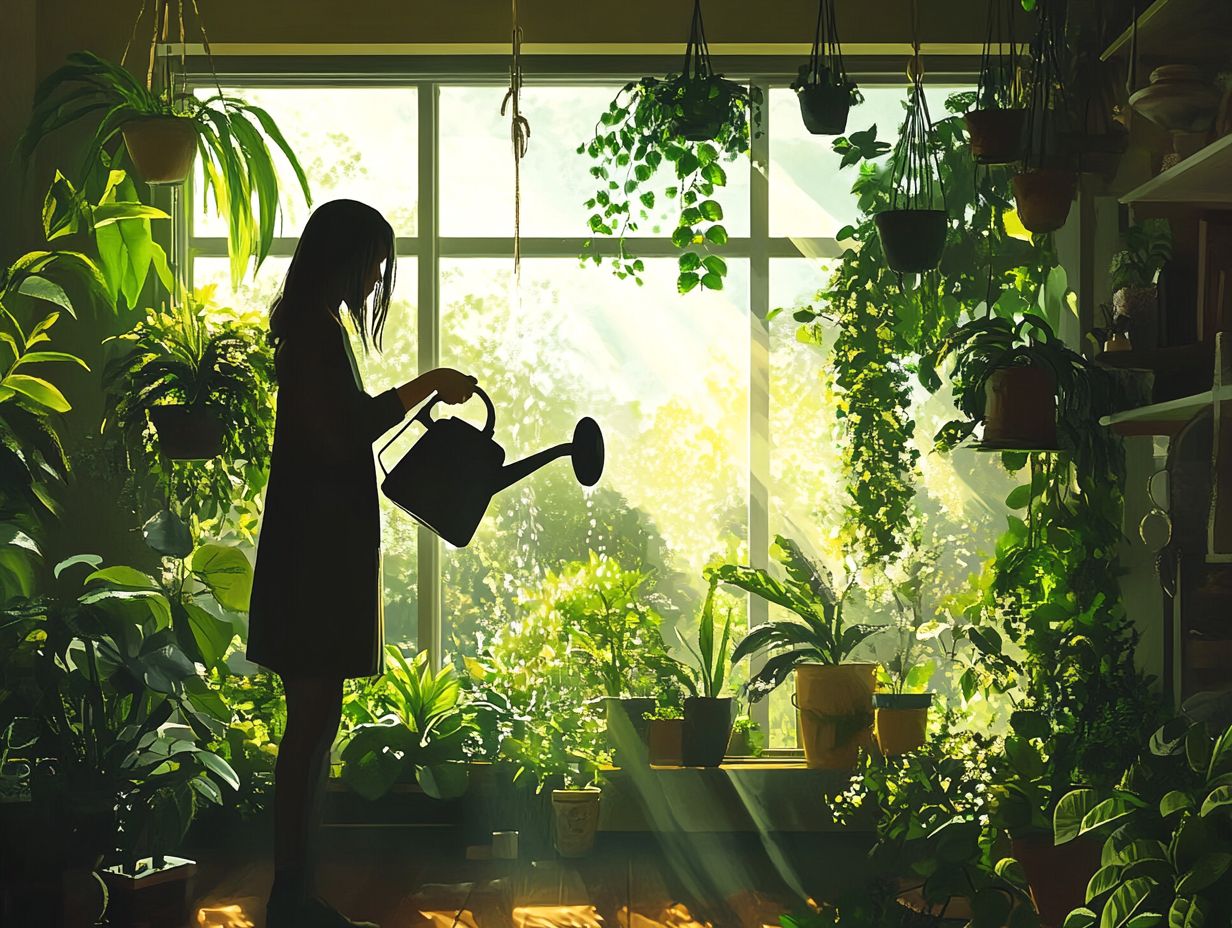
What are the 5 methods to water hanging plants?
The 5 methods to water hanging plants are: hand watering (pouring water directly), self-watering containers (which have a reservoir), drip irrigation (using a system of tubes), wicking (drawing water through a material), and bottom watering (placing pots in water to soak).
Try these tips today and see the difference in your hanging plants!
How do I hand water hanging plants?
To hand water hanging plants, fill a watering can or pitcher with water.
Slowly pour it over the soil until it begins to drain out of the bottom of the pot.
What are self-watering containers and how do they work?
Self-watering containers have a reservoir at the bottom that holds water.
The system pulls water up into the soil as needed, allowing plants to absorb moisture without overwatering.
Can I use drip irrigation for hanging plants?
You can also use drip irrigation for hanging plants.
This method involves a small tube with emitters that slowly release water directly into the soil, making it efficient and hands-free.
How does wicking work for watering hanging plants?
Wicking uses a wick, such as a string or piece of fabric, placed in the potting mix.
One end sits in a water source, absorbing moisture and delivering it to the plant’s roots consistently.
What is bottom watering and when should I use it for hanging plants?
Bottom watering fills a tray or saucer with water, letting the plant’s pot sit in it.
This allows the plant to absorb water from the bottom up, which is great for sensitive plants like African violets!

